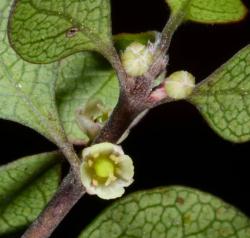- Taxon
- Gallery
- = Aristotelia fruticosa var. α. suberecta Hook.f., Bot. Antarct. Voy. II. (Fl. Nov.-Zel.) Part I, 34 (1852)
- = Aristotelia fruticosa var. β. erecta Hook.f., Bot. Antarct. Voy. II. (Fl. Nov.-Zel.) Part I, 34 (1852)
- = Aristotelia fruticosa var. γ. prostrata Hook.f., Bot. Antarct. Voy. II. (Fl. Nov.-Zel.) Part I, 34 (1852)
- = Aristotelia fruticosa var. δ. microphylla Hook.f., Bot. Antarct. Voy. II. (Fl. Nov.-Zel.) Part I, 34 (1852)
- = Aristotelia erecta Buchanan, Trans. & Proc. Roy. Soc. New Zealand 3: 209 (1870 [1871])
- = Myrsine brachyclada Colenso, Trans. & Proc. New Zealand Inst. 22: 478 (1889 [1890])
- = Aristotelia fruticosa var. rigidula G.Simpson & J.S.Thomson, Trans. & Proc. Roy. Soc. New Zealand 73: 158 (1943)
Much-branched, erect to low-growing, up to 2 m. tall; branches sub-divaricate to ascending, us. rigid, sts entangled; branchlets reddish brown, pubescent. Lvs opp. or in opp. fascicles on arrested branchlets, on petioles ± 2 mm. long. Lamina of 2 forms on different plants: (a) ± 5–7 × 4–5 mm., obovate to oblong, coriac., dark green; (b) ± 15 × 9 mm., of ovate to lanceolate order, less coriac., lighter green; margins distinctly serrate. Fls small, solitary or in small 3–6-fld cymes, pedicels short, pubescent. Sepals 4, oblong, pubescent; petals 4, slightly > sepals, us. with 1–4 crenate teeth. Stamens 4–6, anthers > filaments. Berry 3–4 mm. diam., globose, white, bright pink, dark red to black. Seeds 4-angled. Juvenile plants have narrow-lanceolate to ovate, acute to acuminate lvs; margins variously, us. deeply toothed.
[From: Allan (1961) Flora of New Zealand. Volume 1.]
Flowering: Oct.–Dec.; Fruiting: Nov.–Apr.




